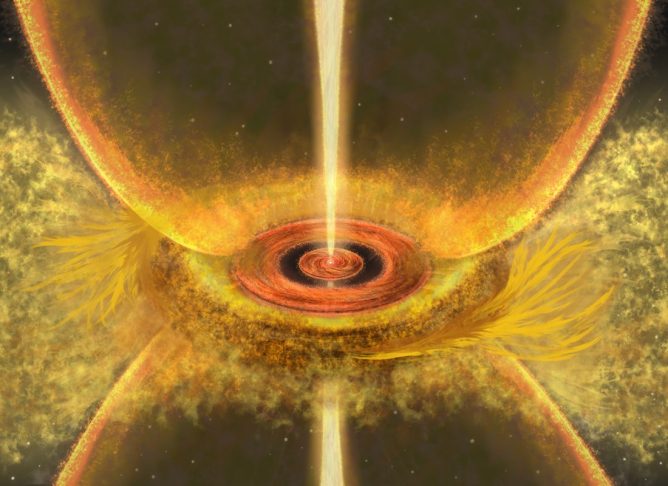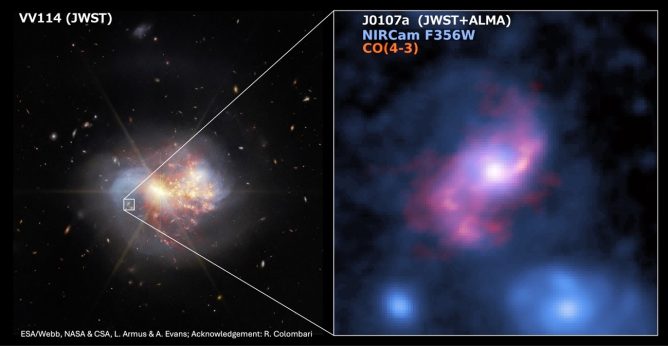Written by Masaaki Hiramatsu, the Education and Public Outreach Officer at NAOJ Chile Observatory
Stars are formed by the contraction of interstellar gas and dust. Around a protostar, gas and dust form a disk in which planets are eventually formed. Then, are the chemical compositions of the interstellar cloud and the disk identical? The new ALMA observations show that the answer is ‘no.’ This finding has a large impact on understandings of the formation process of planets and protoplanetary disks.
A press release on this research,
“A Drastic Chemical Change Occurring in Birth of Planetary System: Has the Solar System also Experienced it?” (PDF)
was issued by The University of Tokyo. Here I give a detailed explanation on it.
The international research team, led by Dr. Nami Sakai, an assistant professor at the Department of Physics, The University of Tokyo, observed a baby star L1527 in the constellation Taurus with ALMA. The team observed radio emission from cyclic-C3H2 [note 1] and sulfur monoxide (SO) molecules to analyze the motion and temperature of the gas around the baby star.
L1527 is a well-known protostar (baby star) and many astronomers have pointed telescopes at it. For example, NASA’s Spitzer Space Telescope took infrared images of the star. The stellar light escapes through a cavity excavated by a powerful bipolar gas flow from the star and illuminates the surrounding gas, which makes a butterfly-shaped nebula extending in the east-west direction (Figure 1). Past radio observations revealed that gas is circling around the star to form a disk and we see the disk edge-on.
Figure 1. An infrared image of the protostar L1527 taken by the Spitzer Space Telescope.
Credit: J. Tobin/NASA/JPL-Caltech
Radio observations by ALMA have the advantage of being able to see the gas directly, which is invisible in infrared light. Various molecules in the gas emit characteristic radiation as radio waves under characteristic conditions (temperature, density, chemical compositions). Therefore astronomers can investigate the nature of the gas by observing various molecules. Also astronomers measure the motion of the gas with the Doppler Effect [note 2]. ALMA’s unprecedented sensitivity enables us to detect weak radio emissions which are undetectable by other telescopes. In fact, because of their low abundances, cyclic-C3H2 and SO emissions are much weaker than, for example, the CO emission observed in detail around L1527 in earlier studies.
Observations of cyclic-C3H2 with ALMA show that the gas forms a disk with a radius of 500 AU (1 AU corresponds to the distance between the Sun and Earth. The distance from the Sun to Neptune is 30 AU) circling around the protostar. Beyond 100 AU, as gas rotates around the protostar it is also infalling towards the star. Inside 100 AU, the emission from cyclic-C3H2 is very weak, which indicates chemical differentiation between the inner and outer disk. The team estimated the gas temperature at -240 to -250 degrees Celsius from the emission strength. On the other hand, SO has a completely different distribution: a ring-like structure with a radius of 100 AU. The temperature of the SO molecules is estimated to be -210 degrees Celsius, which is clearly higher than that of cyclic-C3H2.
Figure 2. L1527 observed by Spitzer (Left) and the distributions of cyclic-C3H2 (center) and SO (right) observed by ALMA. ALMA reveals the gas distribution just close to the protostar. Emission from cyclic-C3H2 is weak toward the protostar but strong at the northern and southern parts. Meanwhile, SO has its emission peak near the protostar.
Credit: J. Tobin/NASA/JPL-Caltech, N. Sakai/The University of Tokyo
Click to enlarge (JPG/ 845KB)
What causes the drastic chemical composition change at 100 AU from the star? Simple simulations show that the infalling gas is inhibited due to the centrifugal force and piles up. This boundary is called the “centrifugal barrier”. The infalling gas collides with the barrier and is warmed up. SO molecules frozen on the surface of cold dust grains are liberated into the gas phase. The temperature decreases inside the barrier and the SO molecules are frozen again. This is the formation process of the SO ring at 100 AU.
Rotating motion dominates inside the centrifugal barrier. Hence, the barrier is the edge of the disk formation region in which eventually a planetary system will be formed. There has been little consideration of the chemical differences between the interstellar clouds and the protoplanetary disks. This is the first evidence for a drastic change in the chemical composition during the formation of a protoplanetary disk.
This research highlights “chemistry in the formation of protoplanetary disks” which was not anticipated before. It is still unknown whether this sharp transition is seen around many protostars or not, and that will be uncovered by future observational studies. This is also important for understanding the formation process of our own Solar System.
Notes
[1] Cyclic-C3H2 consists of three carbon atoms connected to form a loop with two hydrogen atoms attached.

[2] The Doppler Effect is a change in the frequency of a wave emanating from a moving object. You may have heard the difference in frequency between when a car sounding a siren is moving toward to and away from you. Molecules in the Universe emit radio waves with their characteristic frequency, and if the molecules are moving, the frequency shifts slightly due to the effect. By measuring the shift of the frequency very precisely, astronomers estimate the speed and direction of moving gas. It should be noted that we can measure the movement only along the line of sight and it is impossible to measure the movement perpendicular to the line of sight.
Additional note:Measuring the movement of gas from radio observations
Measuring gas motion by the Doppler Effect is one of the techniques in radio astronomy. Let’s have a close look at the observation results to see how it is done.
The figures below show the distribution of cyclic-C3H2 (top-left) and SO (bottom-left). Different frequency components are summed up in these figures and we can see the total amount of the gas. The two diagrams on the right side are so-called “position-velocity diagrams” which present the velocity of the gas at various positions. The vertical axis shows the distance from the protostar and the horizontal axis shows the speed of the gas. The speed of cyclic-C3H2 is close to zero far from the star (top-right). The closer the distance becomes, the faster the speed is. This is similar to the motion of the planets in the Solar System. Inside 100 AU, the emission from cyclic-C3H2 gets weaker. On the other hand, the SO molecule shows completely different motion (bottom-right) and the emission distribution is concentrated in the central 100 AU around the protostar. If the central part was filled with SO molecules, a fast-moving component should be observed as seen in cyclic-C3H2. The absence of such a high-speed component indicates the actual absence of the SO molecule there. Hence, the SO molecules have a ring-like distribution.
The figure below shows a schematic view of L1527 and its relation to the position-velocity diagrams. The schematic diagram on the left shows the motion and distribution of rotating-infalling cyclic-C3H2 and the SO ring at the centrifugal barrier. The central diagram is a graph of the maximum speed of the gas in relation to the distance from the protostar, and on the right is a position-velocity diagram for cyclic-C3H2 (in color) and SO (in contour). Note that the speed along the line of sight is measurable with the Doppler Effect. You can see that the maximum speed of SO is seen at the edge of the ring, and the measured speed of the gas is zero near the protostar.
The image below is L1527 observed by Spitzer and an artist’s impression of the disk structure around L1527. The centrifugal barrier is highlighted in purple.
Credit: Credit: J. Tobin/NASA/JPL-Caltech, N. Sakai/The University of Tokyo
Click to enlarge (JPG/ 478KB)
Figure. Illustration of rotating-infalling gas toward a protostar. The abundance of sulfermonooxcyde is enhanced at the outer edge (colored blue) of a protoplenatry disk.
Credit: The University of Tokyo










